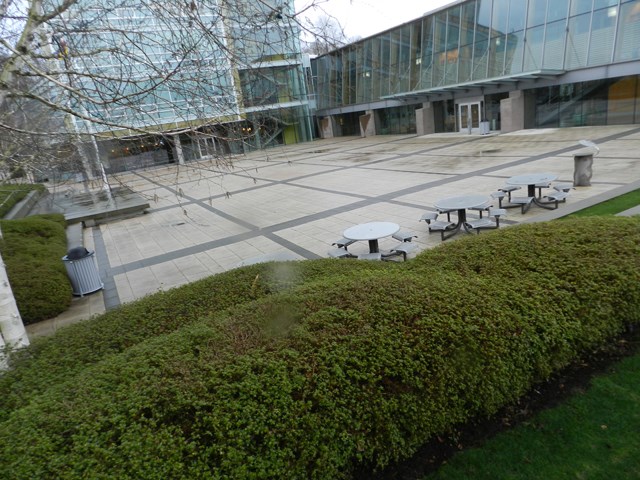What’s rarer in today’s super-heated real estate market than an affordable, traditional style, detached family home?
How about a defined space for the public to gather?
That’s what is driving Vancouver-based architectural firm Public, and one of its principals, Brian Wakelin, into stimulating discussion on trying to find and develop small areas for that purpose. He will be featured in the next Lulu Series: Art in the City presentation on March 24 at Richmond City Hall.
In a region where open space is a precious commodity, why is it important to include public spaces?
Wakelin said venues where the population can participate in shared experiences help create a sense of community.
But with current stratospheric prices for real estate in the region, is there enough motivation to have those public spaces materialize, especially when they would be built mostly with public funds?
“Yes, we have to,” Wakelin said. “Those spaces are vitally important. Civic life unfolds, and it doesn’t do that in a private apartment or home. It happens in places where there’s a collective and shared experience.
“I’m optimistic that it will happen.”
As scarcity for real estate increases, the need for public spaces will intensify and become more important, Wakelin added. And that will create the need for some unique solutions, because in many areas of the Lower Mainland, it has not been adequately provided for based on future population growth.
Many of the bigger cities around the globe that have been deemed “world class” have planned for that and take great pride in their public places for residents and visitors to assemble.
“When you look at the great cities in the world, the public spaces haven’t happened by accident,” Wakelin said. “They have been very internationally designed, created and constructed. Rome, Paris, London, Hong Kong, Tokyo — the spaces where people collect and the images we have when we think of those places haven’t been carefully considered.
“Those cities have evolved over hundreds and in some case thousands of years, and the spaces where people get together are central to what it means to be there,” Wakelin said. “I hope Greater Vancouver will have those kinds of spaces in the future because it certainly does not have them now.”
So, which cities are paying attention to providing public spaces?
Wakelin said Vancouver’s original city plan does a decent job of setting aside tracts of open space. And Surrey is on the list for its efforts to try and match its fast-growing population.
“And I know Richmond is, as well,” Wakelin said. “But I think the places we build and envision for the future have to be thought out more holistically than just park space for passive recreation. They have to be thought out as public spaces for people of all shapes, sizes and abilities.”
One aspect most public spaces share is the ability to attract people. And that is a crucial point, because in many cases if you simply build a public gathering space, people will not automatically come.
“In many cases, successful public spaces are actively programmed,” Wakelin said. “There’s the flower market in Camden Town (London), antique fairs in other parts of the city, and other activities in adjacent areas that help support them, such as cafes.
“You really have to work to make a public space, then work to actively animate them.”
A shining example of that is in Paris, Wakelin said, where areas along the Seine River are turned into temporary beaches for the public to enjoy during the summer months.
“They bring in sand, deck chairs and all kinds of activities for people who are unable to get out to summer vacation spots — it can be very hot in Paris. You can stay and enjoy life by the river,” Wakelin said. “They very consciously set out to make something happen.”
In Richmond, the public space outside city hall is a prime example.
“That’s one that I’ve talked about in the past because Richmond, particularly in that area, is fairly car-oriented,” Wakelin said. “But at least city hall has tried to create a framed, civic space for activities to happen. It’s a good start. But there needs to be a greater network of those spaces that are linked together, are swappable and accessible. When you step out of Richmond City Hall’s kind of civic square, you’re kinda on your own.”
That’s one reason why, in today’s world, the shopping mall has often become the default town or city square where community groups gather and celebrations take place.
“Malls have become the default, but I think it’s within our power to question the viability of how enjoyable those kinds of spaces are,” Wakelin said. “There are so many different ways we can do better and to be inclusive.
“The mall doors are a barrier for many people who live in our city — the marginalized who are prohibited from using those kinds of spaces.”
Wakelin’s presentation on March 24 is the first of three events in the Lulu Series: Art in the City program.
Michael Rohd, founder of the Center for Performance and Civic Practice (Evanston, Illinois) will discuss how art can be a potent tool for public impact and collaboration on April 21, and visual artist, Norie Sato, (Seattle, Washington) will describe her creative process developing site-specific works for public places on May 19.
For more information, visit Richmond.ca/LuluSeries.



